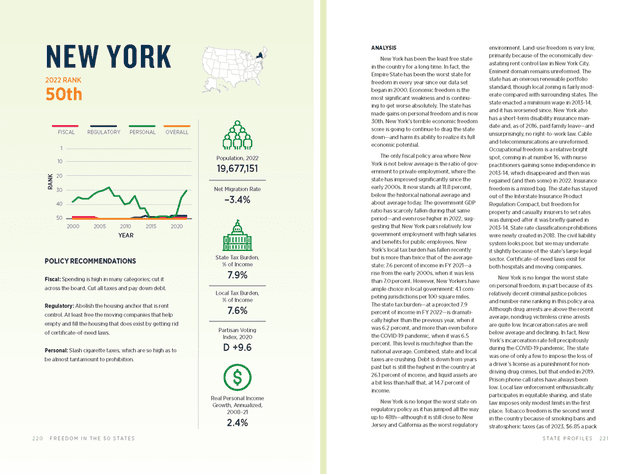Policy Recommendations
- Fiscal Spending is high in many categories; cut it across the board. Cut all taxes and pay down debt.
- Regulatory Abolish the housing anchor that is rent control. At least free the moving companies that help empty and fill the housing that does exist by getting rid of certificate-of-need laws.
- Personal Slash cigarette taxes, which are so high as to be almost tantamount to prohibition.
Analysis
New York has been the least free state in the country for a long time. In fact, the Empire State has been the worst state for freedom in every year since our data set began in 2000. Economic freedom is the most significant weakness and is continuing to get worse absolutely. The state has made gains on personal freedom and is now 30th. New York’s terrible economic freedom score is going to continue to drag the state down—and harm its ability to realize its full economic potential.
The only fiscal policy area where New York is not below average is the ratio of government to private employment, where the state has improved significantly since the early 2000s. It now stands at 11.8 percent, below the historical national average and about average today. The government GDP ratio has scarcely fallen during that same period—and even rose higher in 2022, suggesting that New York pairs relatively low government employment with high salaries and benefits for public employees. New York’s local tax burden has fallen recently but is more than twice that of the average state: 7.6 percent of income in FY 2021—a rise from the early 2000s, when it was less than 7.0 percent. However, New Yorkers have ample choice in local government: 4.1 competing jurisdictions per 100 square miles. The state tax burden—at a projected 7.9 percent of income in FY 2022—is dramatically higher than the previous year, when it was 6.2 percent, and more than even before the COVID-19 pandemic, when it was 6.5 percent. This level is much higher than the national average. Combined, state and local taxes are crushing. Debt is down from years past but is still the highest in the country at 26.1 percent of income, and liquid assets are a bit less than half that, at 14.7 percent of income.
New York is no longer the worst state on regulatory policy as it has jumped all the way up to 48th—although it is still close to New Jersey and California as the worst regulatory environment. Land-use freedom is very low, primarily because of the economically devastating rent control law in New York City. Eminent domain remains unreformed. The state has an onerous renewable portfolio standard, though local zoning is fairly moderate compared with surrounding states. The state enacted a minimum wage in 2013–14, and it has worsened since. New York also has a short-term disability insurance mandate and, as of 2016, paid family leave—and unsurprisingly, no right-to-work law. Cable and telecommunications are unreformed. Occupational freedom is a relative bright spot, coming in at number 16, with nurse practitioners gaining some independence in 2013–14, which disappeared and then was regained (and then some) in 2022. Insurance freedom is a mixed bag. The state has stayed out of the Interstate Insurance Product Regulation Compact, but freedom for property and casualty insurers to set rates was dumped after it was briefly gained in 2013–14. State rate classification prohibitions were newly created in 2018. The civil liability system looks poor, but we may underrate it slightly because of the state’s large legal sector. Certificate-of-need laws exist for both hospitals and moving companies.
New York is no longer the worst state on personal freedom, in part because of its relatively decent criminal justice policies and number-nine ranking in this policy area. Although drug arrests are above the recent average, nondrug victimless crime arrests are quite low. Incarceration rates are well below average and declining. In fact, New York’s incarceration rate fell precipitously during the COVID-19 pandemic. The state was one of only a few to impose the loss of a driver’s license as a punishment for non-driving drug crimes, but that ended in 2019. Prison phone call rates have always been low. Local law enforcement enthusiastically participates in equitable sharing, and state law imposes only modest limits in the first place. Tobacco freedom is the second worst in the country because of smoking bans and stratospheric taxes (as of 2023, $6.85 a pack in New York City, topped only by Illinois’s absurd $7.16-a-pack rate in Chicago). Naturally, the state also has a vaping ban. New York is perhaps the worst state for homeschoolers, and it has no private school choice programs and only a meager public program. Sparklers were legalized in 2015, and mixed martial arts competitions in 2016. Gambling freedom is better than average; casinos were introduced in 2005, and sports and internet betting are now legal. Cannabis freedom—as anyone who has been to New York City lately can attest—is now above average; the state enacted a limited medical marijuana law in 2014, and marijuana was legalized in 2021. Alcohol freedom is a bit above average, with modest taxes, but grocery stores can’t sell wine. Gun rights are hedged about with all kinds of restrictions, but the recent Supreme Court decision in Bruen is helping law-abiding gun owners. Raw milk sales are legal and driver’s licenses were made available to illegal immigrants in 2019, suggesting that even New York paternalism has its limits.

